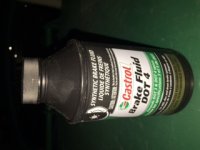I have a 58 100/6 Longbridge car and the Brake master cylinder has deteriorated and is leaking so I have bought another and intend changing it
At the same time I intend flushing the old brake fluid as I have no idea what fluid the previous owner had put in the car or how long it has been in there.
One concern is that the reservoir is a dual reservoir hosting both the brake and clutch fluid so can I change just the brake fluid, which I assume is on the outside of the reservoir, without affecting the clutch fluid which I assume is in the centre of the reservoir
Also should I be using Dot3 or Dot 4 synthetic brake fluid or mineral type brake fluid
If I decide to replace the clutch fluid, where do I find the bleed screw as there is not one on the master cylinder?
At the same time I intend flushing the old brake fluid as I have no idea what fluid the previous owner had put in the car or how long it has been in there.
One concern is that the reservoir is a dual reservoir hosting both the brake and clutch fluid so can I change just the brake fluid, which I assume is on the outside of the reservoir, without affecting the clutch fluid which I assume is in the centre of the reservoir
Also should I be using Dot3 or Dot 4 synthetic brake fluid or mineral type brake fluid
If I decide to replace the clutch fluid, where do I find the bleed screw as there is not one on the master cylinder?

 Hi Guest!
Hi Guest!

 smilie in place of the real @
smilie in place of the real @
 Pretty Please - add it to our Events forum(s) and add to the calendar! >>
Pretty Please - add it to our Events forum(s) and add to the calendar! >> 

